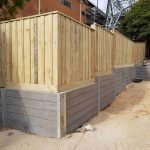Introduction
When it comes to landscaping and residential or commercial property management, maintaining walls play an essential role. These structures are necessary for handling soil erosion, creating functional land space, and even boosting the aesthetic appeal of your residential or commercial property. However, the effectiveness and durability of a retaining wall hinge considerably on one vital element: planning This short article dives deep into the value of proper preparation by your retaining wall home builder and how it can make or break your project.
Why Appropriate Preparation by Your Retaining Wall Home Builder is Crucial
Proper https://canvas.instructure.com/eportfolios/3557306/home/the-advantages-of-working-with-a-local-retaining-wall-contractor planning by your retaining wall builder is essential for a number of factors. Primarily, without a well-thought-out strategy, you run the risk of the wall stopping working to perform its desired function-- supporting soil and avoiding erosion. An inadequately created or constructed wall could lead to serious concerns like foundation damage, landscape degradation, and even security hazards.
Furthermore, planning includes different elements such as product choice (timber sleeper vs. concrete sleeper), structural integrity (using H beams), drain considerations, and aesthetic factors. By understanding these elements in advance, you can conserve yourself money and time in the long run while ensuring a long lasting structure that fulfills all your needs.
Understanding Various Kinds of Maintaining Walls
1. Timber Sleeper Walls
Timber sleeper walls are popular for their natural appearance and versatility. They integrate perfectly with gardens however need meticulous planning to guarantee they can endure the pressures of soil.
- Advantages: Aesthetic appeal, cost-efficient. Disadvantages: Susceptible to rot if not properly treated.
2. Concrete Sleeper Walls
Concrete sleeper walls provide superior strength and resilience compared to lumber choices. They are ideal for high-load circumstances however can be more expensive.
- Advantages: Durability, minimal upkeep required. Disadvantages: Greater preliminary cost.
3. H Beam Reinforced Walls
For significant load-bearing applications or in locations prone to heavy rainfall, utilizing H beams offers unmatched structural support.
- Advantages: Exceptional strength. Disadvantages: Requires skilled labor for installation.
Key Consider Preparation Your Maintaining Wall
4. Soil Analysis
Conducting a thorough soil analysis is important. The type of soil will determine the design requirements for your retaining wall.
- Clay soils might broaden when wet however shrink when dry. Sandy soils drain pipes well however may not provide adequate support.
5. Drainage Solutions
Including efficient drainage options in your strategy is non-negotiable! Water accumulation behind a retaining wall can trigger it to fail catastrophically.
Types of Drain Solutions
- Weep holes Drainage pipes Gravel backfill
The Importance of Regional Regulations
6. Building Codes and Permits
Before starting any construction job, familiarize yourself with regional building codes and permitting processes associated with retaining walls.
- Ensure you're compliant with height restrictions. Some areas may need engineering assessments for taller walls.
Working with Experts in Retaining Wall Construction
7. Choosing the Right Builder
Selecting a skilled professional for constructing your retaining wall is essential! Search for credentials that show knowledge in handling both timber sleeper and concrete sleeper options.

Questions to Ask Prospective Builders
What types of products do you specialize in? Can you provide referrals from previous projects?Design Factors to consider in Your Retaining Wall Plan
8. Visual Integration with Landscape Design
Your retaining wall must not simply be practical; it needs to also improve the beauty of your landscape!
Tips for Aesthetic Integration
- Choose materials that complement existing features. Incorporate plants or decorative stones around the base for additional charm.
Cost Evaluation and Budgeting
9. Understanding Job Costs
Budgeting successfully consists of understanding all possible expenses associated with constructing a maintaining wall.
|Expense Element|Estimated Range|| ---------------------|-------------------|| Product Expenses|$50 - $150 per sq feet|| Labor Costs|$30 - $100 per hour|| Permit Charges|Varies by area|
FAQs about Retaining Walls
1. What is a retaining wall's main purpose?
A retaining wall's primary function is to keep back soil from eroding or collapsing into lower areas on a property while also producing usable flat surfaces for landscaping or structure purposes.
2. How do I choose between timber sleeper and concrete sleeper walls?
Consider elements such as looks, budget plan constraints, toughness requirements, and upkeep preferences when choosing between timber sleeper and concrete sleeper walls.
3. Can I construct a retaining wall myself?
While do it yourself jobs are appealing to conserve expenses, it's a good idea to speak with professionals who have understanding about structural integrity, drainage options, and regional guidelines to prevent future problems.
4. For how long does an appropriately planned retaining wall last?
With correct building using quality products like concrete sleepers or treated lumber sleepers together with excellent drain systems, a well-planned retaining wall can last upwards of 20 years or more!
5. What occurs if my retaining wall fails?
If your retaining wall fails due to bad preparation or execution, it might cause significant home damage including disintegration problems that affect landscaping or even home structures-- leading possibly expensive repairs!
6. How frequently must I check my maintaining wall?
It's smart to examine your retaining wall at least as soon as a year after heavy rainfalls or storms since these occasions can jeopardize structural integrity over time.
Conclusion
In summary, correct planning by your retained wall home builder can not be overemphasized! By diligently thinking about aspects such as material selection (timber sleeper versus concrete sleeper), drainage options, local policies compliance; you'll lead the way towards accomplishing an aesthetically pleasing yet robust structure that stands versus time's test-- a real testament not just of functionality however also artistry within landscape architecture! So don't hurry through this critical stage-- require time now so you will not regret it later!
This comprehensive guide functions as an invaluable resource whether you're pondering installing a brand-new retaining wall or checking out modifications on an existing one; keep in mind that investing effort into thoughtful preparation today will pay dividends tomorrow!